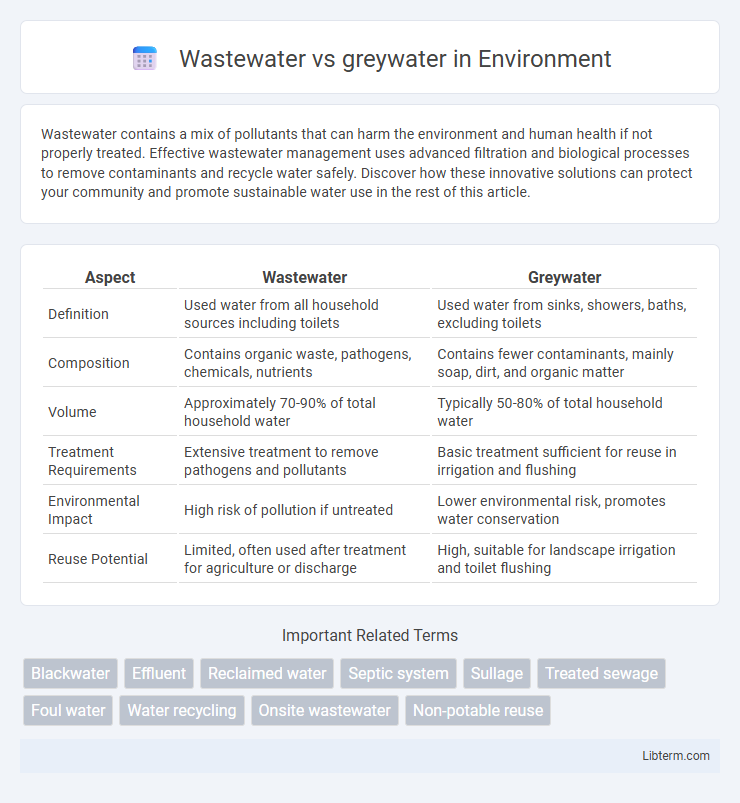Wastewater contains a mix of pollutants that can harm the environment and human health if not properly treated. Effective wastewater management uses advanced filtration and biological processes to remove contaminants and recycle water safely. Discover how these innovative solutions can protect your community and promote sustainable water use in the rest of this article.
Table of Comparison
| Aspect | Wastewater | Greywater |
|---|---|---|
| Definition | Used water from all household sources including toilets | Used water from sinks, showers, baths, excluding toilets |
| Composition | Contains organic waste, pathogens, chemicals, nutrients | Contains fewer contaminants, mainly soap, dirt, and organic matter |
| Volume | Approximately 70-90% of total household water | Typically 50-80% of total household water |
| Treatment Requirements | Extensive treatment to remove pathogens and pollutants | Basic treatment sufficient for reuse in irrigation and flushing |
| Environmental Impact | High risk of pollution if untreated | Lower environmental risk, promotes water conservation |
| Reuse Potential | Limited, often used after treatment for agriculture or discharge | High, suitable for landscape irrigation and toilet flushing |
Introduction to Wastewater and Greywater
Wastewater encompasses all used water from households, industries, and stormwater runoff, containing contaminants from toilets, sinks, and washing machines. Greywater specifically refers to gently used water from sources like showers, bath drains, and bathroom sinks, excluding toilet waste. Understanding the distinction between wastewater and greywater is essential for effective water recycling and treatment strategies targeting environmental sustainability.
Defining Wastewater: Sources and Composition
Wastewater originates from residential, industrial, and commercial activities, encompassing all used water from sinks, toilets, showers, and manufacturing processes. It contains a complex mixture of organic matter, pathogens, chemicals, nutrients, and solids, requiring comprehensive treatment for safe disposal or reuse. Greywater, a subset of wastewater, excludes toilet waste and mainly includes water from baths, sinks, and laundry, typically containing fewer contaminants and lower pathogen levels.
Understanding Greywater: What It Includes
Greywater primarily consists of wastewater from household activities such as bathing, handwashing, laundry, and dishwashing, excluding toilet waste which classifies as blackwater. It typically contains lower levels of contaminants, organic matter, and pathogens compared to blackwater, making it more suitable for treatment and reuse in irrigation or flushing toilets. Understanding the composition of greywater is crucial for developing effective recycling systems and minimizing environmental impact.
Key Differences Between Wastewater and Greywater
Wastewater encompasses all water discharged from households and industries, including sewage, while greywater specifically refers to relatively clean water from sinks, showers, and laundry, excluding toilet waste. Greywater typically contains fewer contaminants and pathogens, making it easier and more cost-effective to treat and reuse for irrigation or flushing toilets. Understanding these distinctions is crucial for effective water management and sustainability efforts in residential and commercial settings.
Environmental Impact of Wastewater vs Greywater
Wastewater contains a mix of organic matter, chemicals, and pathogens that require intensive treatment to prevent environmental pollution, leading to significant energy and resource consumption. Greywater, originating from baths, sinks, and laundry, has lower contaminant levels and presents a reduced environmental impact when reused for irrigation or flushing, mitigating freshwater depletion. Efficient greywater recycling reduces the load on wastewater treatment plants, decreases nutrient runoff into aquatic ecosystems, and supports sustainable water management practices.
Treatment Processes for Wastewater and Greywater
Wastewater treatment involves complex processes such as primary sedimentation, biological treatment using activated sludge or biofilm reactors, and advanced disinfection to remove organic matter, pathogens, and nutrients. Greywater treatment focuses on simpler methods like filtration, sedimentation, and biological treatment in constructed wetlands or membrane bioreactors to remove soap, hair, and organic contaminants for reuse. Both treatment approaches prioritize pathogen reduction and pollutant removal but differ in intensity and technology based on water composition and intended reuse.
Benefits of Greywater Recycling
Greywater recycling reduces freshwater demand by allowing the reuse of wastewater from showers, sinks, and laundry for irrigation and toilet flushing, conserving vital water resources. It lowers the volume of wastewater entering sewage systems, minimizing treatment costs and environmental pollution. Implementing greywater systems supports sustainable water management and significantly decreases household water bills.
Challenges in Wastewater Management
Wastewater management faces significant challenges due to the complex mixture of domestic, industrial, and stormwater contaminants requiring advanced treatment technologies. High levels of organic matter, pathogens, and emerging pollutants like pharmaceuticals complicate conventional treatment efficacy, leading to environmental and public health risks. Infrastructure aging and inadequate funding further hinder effective wastewater treatment and sustainable resource recovery efforts.
Regulatory Standards for Wastewater and Greywater
Regulatory standards for wastewater typically enforce strict limits on contaminants such as biochemical oxygen demand (BOD), total suspended solids (TSS), and pathogens to protect public health and environmental quality. Greywater regulations are generally less stringent, focusing on parameters like chlorine residual and turbidity to allow for safe reuse in irrigation and non-potable applications. Compliance with these standards requires regular testing and treatment processes tailored to the specific characteristics of wastewater or greywater streams.
Sustainable Practices for Water Reuse
Greywater, sourced from household activities like bathing and laundry, presents a lower contamination risk compared to wastewater, which includes sewage and industrial effluents, making it ideal for sustainable water reuse practices such as irrigation and toilet flushing. Implementing greywater recycling systems significantly reduces freshwater demand, conserves water resources, and minimizes the burden on wastewater treatment plants. Advanced treatment technologies for wastewater enable safe reuse in agricultural, industrial, and urban settings, promoting circular water economies and enhancing sustainability in water management.
Wastewater Infographic

 libterm.com
libterm.com